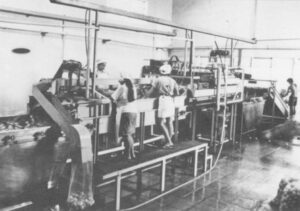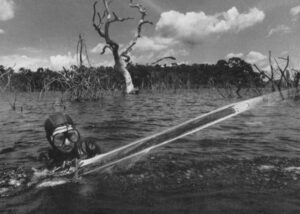Mac Margolis
- 1990

Fellowship Title:
- The Conquest of the Amazon
Fellowship Year:
- 1990
Tropic of Illusions
Takashi Shida bent down in a field of soy beans, briefly disappearing in the sea of pea green stalks that swelled off toward the flat horizon. Surfacing again, he brandished a plant better than a yard long. He grasped it firmly and, as if playing love-me-not with a daisy, tenderly pulled off the flat soya pods, one by one. “Two, three, four,” he reported precisely. It was nearly noon, and shadows had shrunk to almost nothing as the sun ambled towards the zenith. The midday heat was allayed only by the odd breath of wind that made the plantation of soya shiver slightly, like green jello. “Forty-three, forty four,” Takashi continued, beaming now under the bill of his baseball cap. The porcelain blue bowl of sky above him seemed to reflect back his satisfaction. No one took the temperature, but the thermometer would easily have registered ninety, with the barometer pushing a hundred. It was the wet season, and the heat drew up the moisture and held it in the air like a sauna. In

Japanese in the Amazon: The Riddle of Farming the Tropics
TOME-ACU, Brazil–Every evening, when work was done at the farmer’s cooperative, Noburo Sakaguchi would drive home to his small plot of land a few miles out of Tome-Acu, an agricultural village in the eastern Brazilian Amazon region. Sakaguchi, an agronomist by schooling but a woodsman at heart, looked forward to evening when the tedious paper work was done and the searing equatorial sun eased fat and red over the horizon. He would sit down at the long hardwood kitchen table, take a long belt from a can of Pitu cane liquor, climb into a Caterpillar bulldozer and set out for the forest. Every night for two months he maintained this surly ritual, punishing the jungle with his growling machine. In the end, Sakaguchi had bashed a two kilometer road through the woods. To the innocent observer this might seem just a reprise of the age old story of civilization’s assault on nature, a drama that has claimed woodlands from the Black Forest to Borneo. But Sakaguchi’s road was a really a path to invention. Noburo

Forging Controversy: Polluting the Amazon Rain Forest with Factories, Old and New
Acailandia, Brazil-On an August day in the Amazon, when the earth is brown and parched, you can smell this sprawling frontier settlement long before you arrive. Even as the train heaves towards the distant stop, the acrid aroma of charcoal is every where, invading nostrils, clinging to clothing, and even impregnating the clapboard hulls of the shops and homes that flank the main road to town. The skyline is smudged in a permanent dusk of wood smoke and dust, lit only by a ruby moon and the winking blue neon sign of the Santa Maria hotel. Three Brazilians, their bodies covered with charcoal dust, help load wood in the forest surrounding Acailandia. (Photo By Andrew Posner ©1991) The scrap wood fires that glow in the backlots of local sawmills are partly to blame. But mostly, this ashen ambience is the work of hundreds of kilns, ten-foot tall mounds of brick and clay, that blister the gently rolling landscape like a strange pox. All about, armies of half-clad boys, dusted from head to foot in soot,

Hard Rows: The Amazon after Chico Mendes
SERINGAL CACHOEIRA, BRAZIL–It doesn’t look much like a battlefield. A huddle of wooden huts raised on stilts crowns a grassy knoll. Tidy dirt paths stitch the way between the houses. Lush orange trees dot the hill, throwing deep shadows, and at the crest, a pair of goal-posts marks a makeshift soccer field. Children gambol among grazing cows. Now and again, a pair of macaws takes wing, a startling flash of primary red, blue and yellow against the mottled sky. A hundred yards away the jungle begins, a mat green wall rising to a splendid ten-story canopy. A visit to the Cachoeira Extractive Reserve is like walking into some tropical idyll, or a painting by the younger Breughel, as Claude Levi-Strauss once described the Amazon, where “Paradise is portrayed as a place in which plants, animals, and human beings live together in tender intimacy.” Yet it was here, in the western Brazilian state of Acre, near the Bolivian border, that Amazonian labor leader Francisco Alves “Chico” Mendes Filho and the rubber tappers made their stand. Early
